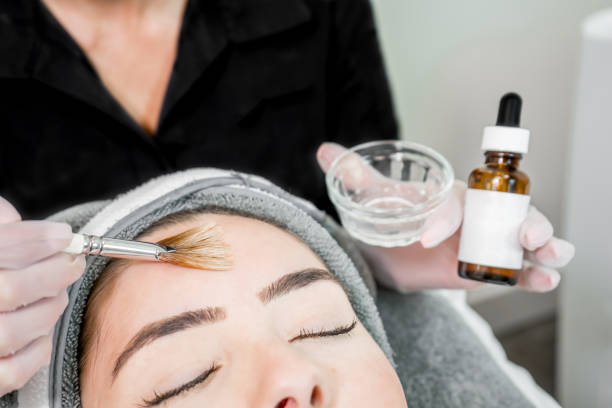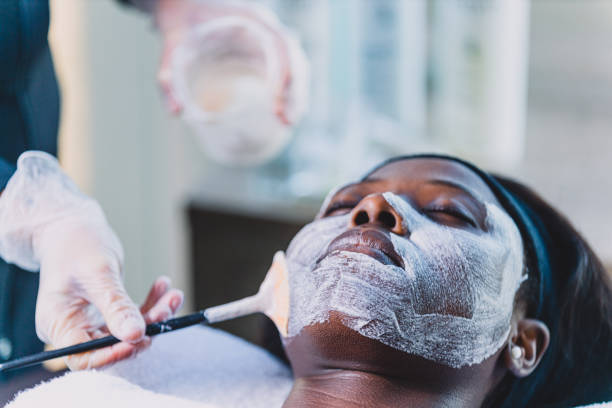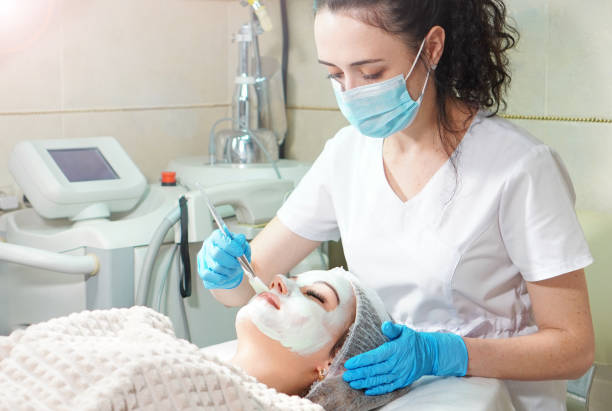Introduction to Chemical Peel Near Me
Chemical peels, commonly searched as “chemical peel near me,” are a popular and effective approach for tackling diverse skin issues. Renowned for their adaptability, these treatments can effectively target problems from acne and wrinkles to uneven skin tone and sun damage. This article explores the world of chemical peels, detailing their advantages, the types available, and the preparatory steps necessary for a chemical peel procedure.
Understanding What Chemical Peels Are
A chemical peel is a treatment in which a chemical solution is typically administered to the skin, most commonly on the face, neck, or hands. These solutions induce the skin to undergo exfoliation, eventually shedding the outer layer and unveiling fresher, healthier skin beneath. The new skin is usually smoother, with fewer blemishes and fine lines, boasting an improved overall texture and tone. Chemical peels use various acids, such as alpha-hydroxy acids (AHAs), trichloroacetic acid (TCA), or glycolic acid, each suited for different skin types and issues.
The Benefits of Chemical Peels
Chemical peels offer several benefits. They can reduce the appearance of scars, acne, and wrinkles, improve the skin’s texture and tone, and promote even-toned skin. Medium and deep peels can provide dramatic results for those looking for a more aggressive treatment for specific skin issues.
Chemical peels additionally enhance skincare products’ efficacy by eliminating the outermost skin layers, enabling these products to penetrate more deeply.

Types of Chemical Peels
Chemical peels are categorized based on the extent to which they penetrate the skin: light, medium, or deep. Chemical peels are categorized based on how deeply they penetrate the skin, with options including light, medium, and deep peels.
Light Chemical Peels
Light chemical peels, also known as superficial peels, gently exfoliate the skin, targeting the outer layer of the skin. They use mild acids like alpha-hydroxy acids and are great options for individuals with mild skin issues like dryness, acne, or slightly uneven skin tone. Light peels are popular as they require minimal recovery time and can be done regularly.
Medium Chemical Peels
Medium chemical peels penetrate the outer and middle layers of the skin. They treat age spots, fine lines, wrinkles, and moderate skin discoloration more effectively.
Medium-depth peels often incorporate ingredients like glycolic acid or trichloroacetic acid. These substances yield more pronounced outcomes than light peels but necessitate a longer recuperation period.

Deep Chemical Peels
Deep chemical peels are the most intensive type of chemical peel treatment. These substances penetrate the skin’s deeper layers and are employed for more intensive treatments, addressing deep wrinkles, scars, or sunspots. Deep peels typically employ phenol or higher concentrations of trichloroacetic acid, delivering the most striking outcomes. Given the depth of the peel, the recovery period is extended, and the procedure may entail greater risk, necessitating a comprehensive consultation with a dermatologist.
Prepping for Your Chemical Peel
Consultation and Skin Evaluation
Before a chemical peel, a consultation with a medical aesthetician or dermatologist is crucial.
During this consultation, your skin type, medical history, and desired outcomes will be examined and discussed. This is also the time to mention any specific needs or concerns, such as sensitive skin types or a particular focus on areas like brown spots or fine lines.
Care Before the Procedure
In preparation for the chemical peel procedure, you might receive recommendations to discontinue using specific skin care products or medications that could influence the results.
Also, it’s essential to be able to offer prior treatments, such as laser skin resurfacing or laser hair removal, as they can impact the effectiveness of the chemical peel.
Many individuals use the search term “Chemical peel near me” when seeking reputable clinics and providers in their vicinity. Selecting a provider with a strong history and experience performing chemical peels is paramount. A chemical peel near me can offer personalized treatment options and follow-up care, ensuring you achieve the best results.

The Chemical Peel Procedure
Step-by-Step Guide to Chemical Peel Procedure
A chemical peel procedure is a meticulous process that involves several steps to ensure safety and effectiveness.
At the outset, the skin is meticulously cleansed to eliminate makeup, oils, or impurities. The type of acid or chemical exfoliant used—be it glycolic acid, salicylic acid, TCA Peel, or another—depends on the desired strength and depth of the peel.
The chemical solution is then carefully applied to the skin, targeting the top layers. During this stage, patients might experience a tingling or burning sensation, which is normal. The solution’s duration on the skin varies based on the type and strength of the peel. In the case of lighter peels, the solution may be neutralized and washed off after a few minutes, while deeper peels might require the solution to remain on the skin for a longer period.
After the specified time, the chemical solution is removed, and a neutralizing substance is applied. The treated skin may appear red and sensitive, similar to a sunburn. Depending on the peel’s depth, a gel or a special post-peel ointment might be applied to soothe the skin and aid the healing process.
Post-Procedure Care and What to Expect
Immediate Aftercare for Chemical Peels
Immediately following a chemical peel, following the post-care instructions provided by the medical spa or clinic is crucial. This might include using gentle cleansers, applying specific moisturizers or healing gels like those containing Kojic Acid or benzoyl peroxide, and avoiding makeup for a certain period.
Ensuring the skin is shielded from the sun is crucial, so wearing broad-spectrum sunscreen is essential. Patients might experience peeling or flaking as the skin heals, which is part of shedding dead skin cells.
Long-Term Care and Maintenance
A consistent skincare routine is recommended to maintain the healthy glow and texture of the skin post-peel.
As suggested by the aesthetician, consistent use of medical-grade skincare products can amplify and extend the outcomes. Additional peel sessions may be recommended to sustain these effects over time, with the frequency ranging from weeks to months, contingent upon the specific peel and individual skin reaction.

Risks and Complications
Possible Side Effects
While chemical peels are generally safe, they have potential side effects, particularly in medium to deep peels.
Typical adverse effects encompass redness, dryness, and peeling. In some cases, there might be swelling, scarring, or changes in skin colour. It’s important to discuss these risks with your provider before the procedure.
Handling Complications in the Aftermath
In case of complications or unexpected reactions, immediate consultation with the provider is necessary. Following their guidance rigorously is crucial for managing any adverse effects.
Finding a Chemical Peel Near Me
Criteria for Choosing Your Aesthetician
When searching for a “chemical peel near me,” consider the expertise and credentials of the aesthetician. Look for providers with extensive experience in chemical peels and positive client reviews. A visit to the office or medical spa can give you an idea of the place’s professionalism and cleanliness.
Importance of Location in Your Search
Convenience is key when undergoing chemical peels, especially for treatments requiring multiple sessions. Choosing a provider near your location saves time and makes it easy for you to have follow-up appointments and consultations. Utilizing the internet for “chemical peel near me” can efficiently find top-rated providers in your area, like in Toronto, Richmond Hill or other specific locations.
Questions to Ask When Considering a Local Chemical Peel
What to Ask During Your Consultation
When considering a chemical peel near you, being well-informed is essential. During your consultation, ask about the main types of chemical peels available and which are best suited for your skin type. Inquire about how the peel will target the top layers of your skin and what improvements you can expect in the appearance of your skin. It’s also important to discuss any potential risks, such as the unauthorized use of your personal information or risks associated with the procedure itself.
Understanding Procedure Costs and Packages
Understanding the cost is a crucial step. Ask about the peel’s pricing and if any packages or deals are available. Some medical spas or clinics might offer a series of peels at a discounted rate. Additionally, inquire if the cost includes post-peel care products, like Vivier Peel kits, or if these are additional expenses.
Success Stories and Before-and-After Pictures
Stories from those who've Undergone Chemical Peels
Listening to stories from clients who have undergone chemical peels can provide valuable insights. These testimonials can offer a realistic perspective on what to expect regarding results, the healing process, and the overall experience. You might learn how the peel helped reduce pores, improve texture, and provide a healthy skin appearance.
Visual Proof: Before and After the Treatment
Before-and-after pictures serve as visual proof of what chemical peels can achieve. These images can display the transformation of the uppermost layers of the skin, showcasing improvements in areas such as fine lines, acne scars, and the overall radiance of the skin. These images are often available at the clinic or on their website and can be a great tool for understanding potential outcomes.
Conclusion: Chemical Peel Near Me, Are They Worth It?
Weighing the Pros and Cons
Chemical peels provide many advantages, such as enhanced skin texture, reduced dead cells, and a youthful appearance. However, they also come with risks, such as redness, peeling, and, in rare cases, more severe reactions. Weigh these factors based on your skin’s needs, medical history, and the information provided by your aesthetician.
Making the Decision for Your Skin Health
Deciding whether a chemical peel is right for you depends on various factors. Please look at your skin goals, condition, and willingness to undergo the procedure and follow the necessary aftercare. A chemical peel can be a transformative step in your skincare regimen if the advantages align with your expectations and skin health needs.
In summary, when exploring “chemical peel near me” options, you must arm yourself with information, understand the costs, listen to success stories, and critically weigh the pros and cons. With the right approach, chemical peels can be an excellent investment in your skin health, contributing to a more radiant and youthful appearance.
Remember that the crucial step is making a well-informed choice and selecting a trustworthy expert to provide guidance.
Book Your Free Consultation Today Or Call (647) 560-9233
By providing your phone number you agree to receive informational text messages from laserskin.ca. Consent is not a condition of purchase. Message frequency will vary. Msg & data rates may apply. Reply HELP for help or STOP to cancel.
